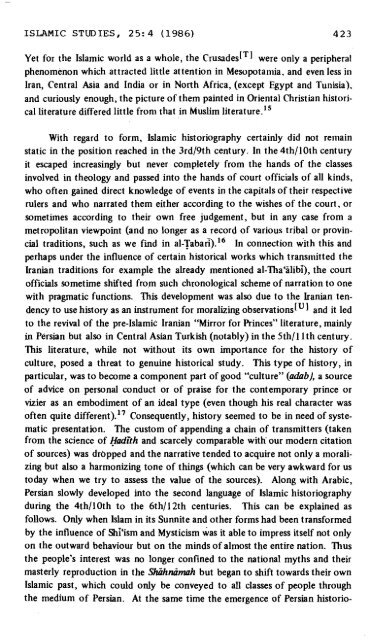ISLAMIC & WESTERN HISTORIOGRAPHY
ISLAMIC & WESTERN HISTORIOGRAPHY
ISLAMIC & WESTERN HISTORIOGRAPHY
You also want an ePaper? Increase the reach of your titles
YUMPU automatically turns print PDFs into web optimized ePapers that Google loves.
<strong>ISLAMIC</strong> STUDIES, 25: 4 (1986) 423<br />
Yet for the Islamic world as a whole, the ~rusades[~] were only a peripheral<br />
phenomenon which attracted little attention in Mesopotamia, and even less in<br />
Iran, Central Asia and India or in North Africa, (except Egypt and Tunisia).<br />
and curiously enough, the picture of them painted in Oriental Christian historical<br />
literature differed little from that in Muslim literature.''<br />
With regard to form, Islamic historiography certainly did not remain<br />
static in the position reached in the 3rd/9th century. In the 4th/lOth century<br />
it escaped increasingly but never completely from the hands of the classes<br />
involved in theology and passed into the hands of court officials of all kinds,<br />
who often gained direct knowledge of events in the capitals of their respective<br />
rulers and who narrated them either according to the wishes of the court. or<br />
sometimes according to their own free judgement, but in any case from a<br />
metropolitan viewpoint (and no longer as a record of various tribal or provin-<br />
cial traditions, such as we find in al-yabad).16 In connection with this and<br />
perhaps under the influence of certain historical works which transmitted the<br />
Iranian traditions for example the already mentioned al-Tha'ilib'i), the court<br />
officials sometime shifted from such chronological scheme of narration to one<br />
with pragmatic functions. This development was also due to the Iranian ten-<br />
dency to use history as an instrument for moralizing observations[U] and it led<br />
to the revival of the pre-Islamic Iranian "Mirror for Princes" literature, mainly<br />
in Persian but also in Central Asian Turkish (notably) in the 5th/ll th century.<br />
This literature, while not without its own importance for the history of<br />
culture, posed a threat to genuine historical study. This type of history, in<br />
particular, was to become a component part of good "culture" (adab), a source<br />
of advice on personal conduct or of praise for the contemporary prince or<br />
vizier as an embodiment of an ideal type (even though his real character was<br />
often quite different)." Consequently, history seemed to be in need of syste-<br />
matic presentation. The custom of appending a chain of transmitters (taken<br />
from the science of Hrrdih and scarcely comparable with' our modern citation<br />
of sources) was dropped and the narrative tended to acquire not only a morali-<br />
zing but also a harmonizing tone of things (which can be very awkward for us<br />
today when we try to assess the value of the sources). Along with Arabic,<br />
Persian slowly developed into the second language of Islamic historiography<br />
during the 4thllOth to the 6thl12th centuries. This can be explained as<br />
follows. Only when Islam in its Sunnite and other forms had been transformed<br />
by the influence of ShI'ism and Mysticism was it able to impress itself not only<br />
on the outward behaviour but on the minds of almost the entire nation. Thus<br />
the people's interest was no longer confined to the national myths and their<br />
masterly reproduction in the Shiihruimah but began to shift towards their own<br />
Islamic past, which could only be conveyed to all classes of people through<br />
the medium of Persian. At the same time the emergence of Persian historio-
















